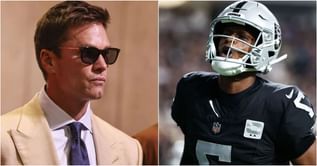
Tony Pollard is the current starting running back for the Dallas Cowboys in the NFL. Playing his first few seasons behind Ezekiel Elliot, Pollard has now stepped into the starting role following Elliot being released this year. Pollard offers the Cowboys more flexibility, a better running game, and most importantly is a good receiving option to have out of the backfield as well.
Pollard came into the league as a relatively less experienced running back as he started playing the position only in his sophomore year of college. Previously, the young Memphis Tigers’ player played as a wide receiver. This is perhaps the main reason why he fell so much in the 2019 draft, eventually getting selected in the fourth round. Yet, Pollard has added a lot of value to the team and should now look to break out this year with some exciting performances.
Tony Pollard Q Collar
Very recently, there have been a few players such as Tony Pollard who can be seen wearing a band-like thing around their necks. At first, you may have thought that it was another piece of the NFL player’s uniform, but that is not the case. This little band is actually called a Q-collar.
Q collars were designed by a company called Q30 and they are mainly used by football players to reduce the number of concussions they are prone to suffering. Gridiron football as everyone knows is a contact sport which includes a lot of physical abuse to the body.
Suzanne Williams from the Q30 company shared some interesting insights about the Q collar where she described it as a class 2 medical device and has received FDA approval. Getting into the technicalities of how the device actually works is a very interesting concept for anyone who truly wants to understand its functioning and whether or not it is as useful as depicted.
How does a Q collar work
What the device does is it applies slight pressure on the wearer’s jugular veins. This pressure still allows blood to follow normally into the brain, but it slows down the blow flow as it returns from the brain back to the heart. As a result of which, there is still some amount of extra blood to remain inside the skull. That extra blood fills in the gaps in the brain thereby helping to reduce brain slosh. This is an extremely important way of limiting brain injuries such as concussions as sloshing of the brain inside the skull leads to injuries.
In layman’s terms, brain sloshing occurs whenever we move as the brain is floating inside the skull and there is some gap in between. What the Q collar tries to do is apply slight pressure on the jugular veins to slow the blood circulating back towards the heart, meaning the excess blood can now fill in the gap between the brain and the skull thus making the brain unable to move around which obviously limits the chances of injury.
Importance of Q Collar in Football
Although the Q collar is still making its way into the world of sports, its advantages are worth investing in. Williams emphasized the fact that the Q collar is not restricted to just football but all types of athletes. Even sports with limited contact are still capable of causing brain-related injuries so preventing that is the number one priority.
All the more, it is especially essential in contact-heavy sports as the hits taken lead to many more injuries than other sports. Hard tackling, hitting the ground directly on the head, or even having your direction changed quickly can all result in brain slosh as the impact is not only harsh but also sudden. Therefore, with the Q collar in place, there is a little bit of extra chance to prevent such types of injuries or concussions players so often face on the football field.
FAQs
A. Tony Pollard was drafted by the Dallas Cowboys in 2019 and has been playing for the same team since then.
A. Tony Pollard wears a medical device around his neck called the Q collar. It helps reduce brain injuries such as concussions by applying slight pressure on the jugular veins.
A. Tony Pollard will become the Cowboys starting running back after Ezekiel Elliot was released.
A. Tony Pollard ideally plays as the running back in the NFL. Earlier he used to play as a wide receiver while in college so he is a versatile player.









